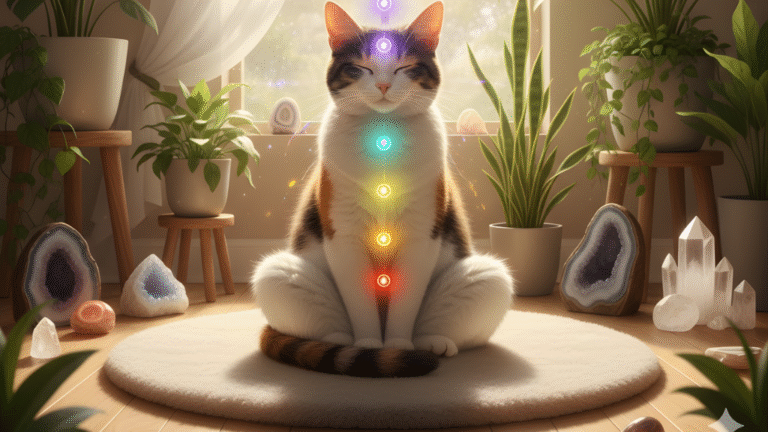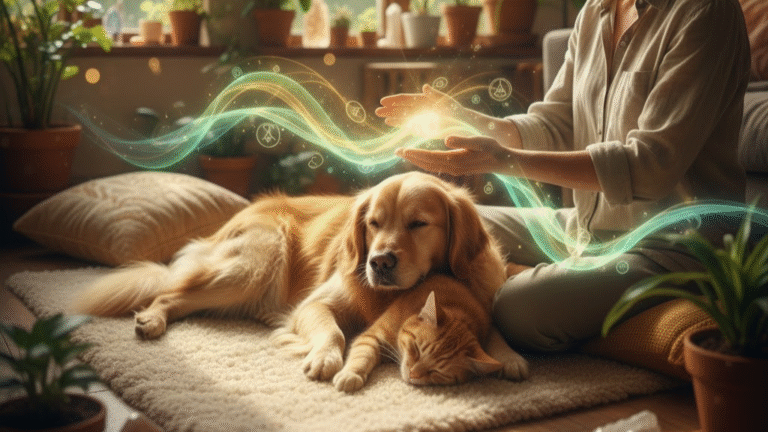The History Of Reiki And Its Applications To Pets
Reiki has become a familiar term in wellness circles, but the history of Reiki and its applications to pets goes far deeper than a trending practice.
Rooted in ancient Japanese traditions, Reiki emerged as a gentle, holistic way to support emotional and physical well-being.
Over time, it evolved from a human-focused healing method into a compassionate practice embraced by pet lovers, veterinarians, and animal caregivers around the world.
As more people turn to natural approaches for their pets, Reiki has stepped into the spotlight as a calming and supportive method that pairs beautifully with modern veterinary care.
To truly understand why it resonates so deeply with animals—and the humans who love them—it helps to explore the history of Reiki and its applications to pets, from its earliest beginnings to the soothing practice many pet owners rely on today.
Let’s take a closer look at where Reiki started, how it grew, and why pets respond so intuitively to this peaceful form of energy support.
What Is Reiki? A Gentle Introduction
Reiki is often described as a simple yet profound healing technique. At its core, it’s a method where practitioners channel universal life energy—referred to as rei (universal) and ki (life force)—to encourage balance, harmony, and well-being in the recipient.
Unlike massage or physical manipulation, Reiki is noninvasive. Practitioners use light touch or place their hands slightly above specific areas of the body, allowing energy to flow where it’s needed most. The intention is not to fix or diagnose but to support the natural healing processes already present within the body.
The Origins Of Reiki
Reiki’s modern practice began with Dr. Mikao Usui in early 20th-century Japan. His exploration of spiritual development, healing, and energetic awareness led him to develop a system of hand placements, meditative practices, and guiding principles designed to promote peace and wellness.
His teachings emphasized living with gratitude, kindness, and mindfulness—values that still sit at the heart of Reiki today.
The Principles Behind The Practice
Although simple, Reiki’s principles offer a roadmap for a balanced, peaceful life.
They encourage practitioners to avoid worry, cultivate gratitude, be honest and diligent, and show compassion toward others.
These principles aren’t just philosophical; they shape the quiet, grounded energy that practitioners aim to bring into every session—whether with humans or animals.
From Humans To Animals: How Reiki Expanded
Reiki may have started as a human wellness practice, but its transition into the world of animals happened naturally and gently over time.
1. The First Observations
Practitioners began noticing something interesting during sessions with people: their pets often wandered over, settled nearby, and appeared soothed by the calm, focused energy in the room.
Some animals even positioned themselves under the practitioner’s hands, as if requesting attention. These small moments sparked curiosity. If animals responded so readily, could they benefit directly from Reiki?
2. The Growth Toward Animal Reiki
As more practitioners experimented, animals consistently reacted in ways that suggested comfort, curiosity, or calm.
Over time, Reiki for pets found its place in:
-
Shelters
-
Veterinary clinics
-
Rescue organizations
-
Rehabilitation centres
-
Home wellness routines
This expansion wasn’t forced—animals guided it. Their sensitivity to energy, body language, and emotional shifts made them natural participants in Reiki sessions.
3. Why Animals Respond So Well
Animals live through instinct, connection, and presence.
They’re highly attuned to subtle changes in emotion, tone, and energy, often more than humans.
Reiki aligns beautifully with this sensitivity.
Its gentle, hands-off approach makes it ideal for:
-
Nervous pets
-
Seniors
-
Animals recovering from trauma
-
Pets undergoing medical treatment
-
Shy or sensitive species
Reiki’s evolution from human-focused care to a cross-species healing practice reflects how universal the need for calm, trust, and balance truly is.
Reiki Techniques And Training: How Practitioners Learn
To understand how Reiki works for pets, it helps to look at the foundation of the training itself.
1. Hands-On And Hands-Off Techniques
Practitioners use hand positions designed to support energy flow through the body. With pets, these gestures become fluid—guided by the animal’s comfort level.
Some animals welcome gentle touch, while others prefer hands hovering a few inches away. The key is responsiveness, respect, and observation.
2. Levels Of Reiki Training
Training is offered in progressive stages:
-
Level 1 focuses on self-healing and basic techniques
-
Level 2 introduces deeper energetic tools and distance Reiki
-
Advanced levels / Master training emphasize attunements and spiritual development
Those who specialize in animal Reiki learn to interpret animal body language, gain skills in consent-based interaction, and understand how different species respond to energy work.
3. Attunements: Opening The Channel
Attunements are unique to Reiki. They’re energetic initiations performed by a qualified instructor to help open a practitioner’s ability to channel energy more effectively. Like tuning an instrument, attunements help practitioners connect more clearly with the energy around them.
4. Finding Reputable Reiki Training
Because Reiki is unregulated globally, it’s essential to choose training programs with:
-
Clear ethical guidelines
-
Positive reviews
-
Focus on animal-specific applications if that’s your goal
-
Instructors with real experience working with pets
Picking the right instructor helps ensure practitioners approach animals with skill, sensitivity, and respect.
Want to Grow Your Reiki Practice Gently?
If you feel called to share your healing gifts with more pets and their families, there are heart-centred ways to turn your passion into a sustainable income. This guide explores ethical, meaningful ways to earn within the Pet Reiki niche without losing your spiritual focus.
🌟 Please read: How To Start An Animal Reiki BusinessBenefits Of Reiki For Pets: Real-Life Applications
Reiki offers a wide range of benefits for animals, supporting both emotional and physical well-being. Many pets experience stress, fear, pain, or confusion during different stages of their lives, and the gentle nature of Reiki makes it a calming addition to their care routine.
One of the biggest advantages is how non-invasive it is. Pets who dislike being handled or are sensitive to touch can still receive Reiki comfortably through hands-off methods.
The calming atmosphere alone can help lower stress levels and create a sense of safety. For pets recovering from surgery, illness, or chronic conditions, Reiki may help ease discomfort by encouraging deep relaxation.
When animals relax, their bodies are better able to engage natural healing processes. This can lead to improved rest, a more balanced mood, and greater resilience during recovery. Reiki also plays a meaningful role in emotional healing.
Animals with trauma histories, anxiety, reactivity, or behavioural challenges may respond positively to the grounding energy practitioners offer.
Over time, many pets begin to trust more deeply, feel safer in their environment, and display more stable behaviour. Pet parents often share stories about the changes they notice after sessions.
A hyperactive dog may finally settle, a nervous rescue cat may become more affectionate, or an elderly pet may rest more comfortably.
These aren’t dramatic, instant transformations—but they are steady, reassuring signs that Reiki is helping the animal feel supported and understood. Reiki isn’t a replacement for veterinary care, training, or behaviour support.
Instead, it complements traditional approaches by providing emotional relief and nurturing calm. When pets feel safe and grounded, everything else in their care plan works more effectively.
Considerations And Ethical Practices In Pet Reiki
Working with animals requires a deeper level of awareness than working with humans. Since pets can’t verbally express their comfort or give direct consent, practitioners must pay close attention to subtle cues.
Signs of relaxation—like sighing, softening muscles, or choosing to lie closer—indicate comfort. Signs of discomfort—like turning away, pacing, or leaving the room—should always be respected. In animal Reiki, consent is fluid, and the animal guides the session.
Another important ethical point is recognizing when Reiki isn’t appropriate. If a pet is in medical crisis, showing severe distress, or requires urgent veterinary attention, Reiki should never be used as a substitute for proper care.
Instead, it may be incorporated afterward as a supportive measure once the animal is stable. The environment matters too. Reiki sessions work best when the space is free from loud noises, sudden distractions, or overwhelming smells.
Whether the session is at home or at a practitioner’s location, the goal is to create a quiet, familiar atmosphere that promotes relaxation.
Practitioners should also be honest about what Reiki can and cannot do. Claiming that Reiki cures illnesses or replaces veterinary treatment goes against ethical practice.
Responsible practitioners collaborate with pet owners and, when possible, communicate with the pet’s veterinarian to maintain a well-rounded care plan.
At the heart of ethical Reiki practice is compassion—respect for the animal’s autonomy, emotional state, and boundaries. When these elements are honoured, Reiki becomes a safe and meaningful tool for supporting pets through all stages of life.
Real-World Examples Of Animal Reiki
Reiki has found a home in many different environments, from family living rooms to bustling rescue shelters. These real-world scenarios highlight its flexibility and gentle strength.
1. Shelter Animals
Many shelters introduce Reiki to help newly arrived or fearful animals settle. Shy or anxious pets often gravitate toward practitioners, showing small but hopeful signs of increased trust. Reiki can help them decompress from stressful situations and adjust more smoothly to new surroundings.
2. Senior Pets And Hospice Care
Reiki is frequently used for aging animals or pets receiving end-of-life care. It may help relieve discomfort, encourage deeper sleep, and support emotional peace. Many pet parents value the comfort it brings during these tender stages.
3. Recovering Or Injured Pets
Animals healing from surgery or illness sometimes benefit from the calm energy Reiki provides. When stress is reduced, recovery can feel less overwhelming, and pets may cope better with follow-up treatments or medication schedules.
4. Pets Experiencing Major Life Transitions
Moving homes, introducing a new baby, or welcoming another pet can be stressful. Reiki offers grounding support that helps animals adapt and regain their sense of balance.
These examples don’t promise miracles—they simply show how Reiki often helps pets feel more supported, calmer, and safer. For many families, those changes are incredibly meaningful.
The Future Of Reiki For Pets: Innovations And Insights
As interest in holistic pet care continues to grow, Reiki is becoming more visible and widely accepted within the wellness world.
Pet parents are increasingly open to gentle approaches that support emotional and physical balance, and Reiki fits naturally into this movement.
Veterinary clinics, rehabilitation centres, and rescue groups are slowly weaving Reiki into their care options. While it’s not yet mainstream everywhere, the willingness to integrate energy-based support alongside traditional medicine shows how perspectives are shifting.
Research into energy healing is progressing too—gradually, but steadily. More studies are exploring how relaxation, intention, and gentle energy techniques may affect animals’ stress levels, heart rates, and behaviour.
As scientific understanding deepens, it will help bridge the gap between holistic and conventional veterinary care. Technology is also opening new doors.
Virtual Reiki sessions, apps that guide pet owners through simple hands-off techniques, and online training programs make Reiki more accessible than ever.
These tools help families explore energy work from home, especially useful for nervous or mobility-restricted pets. Globally, Reiki is becoming a recognized part of integrative pet wellness.
With continued learning and open-minded exploration, the future looks bright for animals who thrive with gentle, supportive care. Reiki offers connection, calm, and comfort — things every pet deserves.
Frequently Asked Questions
Q1: Is Reiki Safe For All Pets?
Yes. Reiki is gentle and adaptable for dogs, cats, rabbits, birds, horses, and even reptiles. A skilled practitioner adjusts the approach to match each species’ comfort level.
Q2: Can Reiki Cure Illnesses?
Reiki does not cure medical conditions. It supports relaxation and emotional balance, which can complement veterinary care and help pets cope more comfortably with treatments.
Q3: How Often Should My Pet Receive Reiki?
The ideal frequency depends on your pet’s needs. Some pets benefit from weekly sessions at first, while others do well with occasional support during stressful periods or transitions.
Q4: Do Pets Need To Be Still During A Session?
Not at all. Many animals walk around, change positions, or wander in and out. Practitioners adjust to the pet’s pace and comfort.
Q5: Can I Learn Reiki To Help My Own Pet?
Absolutely. Many pet owners choose to learn basic Reiki techniques so they can offer gentle support at home. Look for reputable training, especially those with animal-focused components.
Q6: Does Distance Reiki Work For Animals?
Yes, many practitioners offer effective distance sessions. Sensitive or nervous pets often do well with remote Reiki because they can stay in their familiar environment.
Q7: How Long Does A Typical Reiki Session For Pets Last?
Most sessions last between 20 and 45 minutes, depending on your pet’s comfort level. Some animals settle quickly, while others prefer shorter sessions with breaks. A good practitioner follows your pet’s cues rather than the clock.
Q8: Can Reiki Help Rescue Pets With Trauma Or Anxiety?
Yes, many rescue organizations use Reiki because it creates a calm, non-invasive space for healing. Reiki can help frightened or traumatized animals feel safer, gradually reducing fear-based behaviours over time.
Q9: What Should I Do After My Pet’s Reiki Session?
Give your pet a little quiet time and let them choose what they want — rest, a walk, water, or extra affection. Avoid overstimulation right after a session, as many pets become sleepy or relaxed.
Q10: How Do I Know If My Pet Is Benefiting From Reiki?
Look for gentle signs: softer body language, calmer behaviour, deeper sleep, reduced tension, or more affectionate interactions. Some changes are immediate, while others appear gradually over several days.
Wrapping Up: Reiki And Your Pet
Exploring Reiki for your pet opens the door to more calm moments, deeper connection, and gentle support. Whether your goal is easing stress, helping your companion through recovery, or simply creating more comfort in their daily life, Reiki offers a peaceful path forward.
Animals tend to respond beautifully when they’re given space, patience, and compassionate energy. With the right practitioner — or by learning a bit yourself — you can offer your pet a soothing experience that aligns with their natural rhythms.
Thank you for taking the time to explore how Reiki’s history, evolution, and modern practices shape this gentle healing art. Your pet’s wellness journey is unique, and Reiki can be a meaningful part of it.
I trust you enjoyed this article on The History of Reiki and Its Applications to Pets. Please stay tuned for more Reiki insights, pet wellness tips, and holistic lifestyle ideas.
Take care!
— JeannetteZ
💬 Your Opinion Is Important To Me
Do you have thoughts, ideas, or questions? I’d love to hear from you. Please leave your comments below or email me directly at Jeannette@pawreiki.com.
📚 More PawReiki Reads — Discover Energy Healing & Holistic Pet Wellness
💜 My #1 Recommendation for Online Success
Reiki has brought so much peace and purpose to my life, and sharing it online has been a true blessing. If you’ve ever dreamed of creating a gentle income stream around your love for animals and holistic healing, this platform gives you all the tools, training, and community support you need — no tech experience required.
🌟 See How Reiki Lovers Build Online Income — Try WA FreeNo credit card required · Free starter training included
Disclosure
This post may contain affiliate links. As an Amazon Associate and participant in other affiliate programs, I earn from qualifying purchases at no extra cost to you. Please read my full affiliate disclosure.







